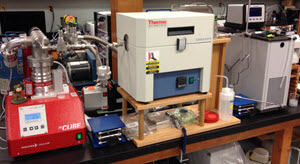
The mass spectrometer used to measure nitrogen compound in sediment samples to calculate denitrification rates. Photo credit: B. Mortazavi
The post explains that a mass spectrometer, or mass spec for short, has become an important tool in many aspects of science including genetics, biochemistry, pharmaceuticals, environmental science, geology and ecology. The mass spec is an instrument that tells us the masses of specific chemical elements in a sample. Briefly, a mass spec works by converting all of the chemical elements in a liquid, solid or gas sample to ions (‘ionizing’). The instrument then sorts or separates the ion based on their mass (specifically their mass to charge ratio) by applying a magnetic or electric field. A detector then records the specific ions present at specific times in the stream of ions.
An ion is a charged (positive or negative) molecule. A mass spec creates these charged particles by firing electrons at the sample until it all breaks apart. The ions are then shot into an electric or magnetic field. This field causes the ions of different charge to move to the detector at different rates from the chamber where the field is applied. Just as a lighter box is easier to shove than a heavier one, lighter ions are deflected more than heavier ones and reach the detector first.
For more educational entries from the ACER blog, head to the ACER Happenings page.
